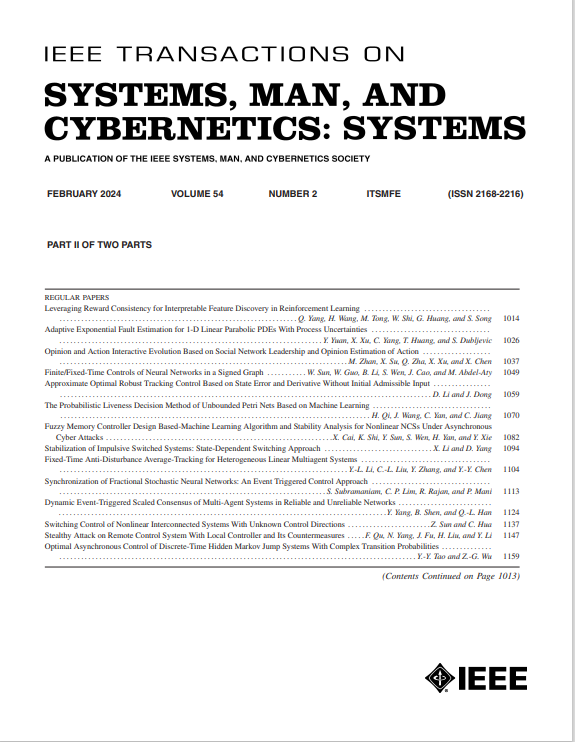Adaptive Event-Triggered Optimal Control With Regulative Learning Rate Under Aperiodic DoS Attacks
IF 8.7
1区 计算机科学
Q1 AUTOMATION & CONTROL SYSTEMS
IEEE Transactions on Systems Man Cybernetics-Systems
Pub Date : 2025-07-16
DOI:10.1109/TSMC.2025.3583832
引用次数: 0
Abstract
In this article, the optimal control for a nonlinear affine system under aperiodic Denial-of-service (DoS) attacks is investigated. To solve the Hamilton–Jacobi–Bellman (HJB) equation, an adaptive dynamic programming (ADP) algorithm based on a single critic network is developed. The proposed regulative learning rate strategy outperforms traditional fixed-rate gradient descent approaches found in existing works. With the objective of minimizing the performance index, the optimal value function and the optimal controller are derived from the approximate solution of the HJB equation. To alleviate the resource demand and enhance the flexibility of the threshold function, an adaptive event-triggered (AET) scheme integrating the idea of sampling control and event-triggered strategy is applied to the optimal control initially. Compared with the static event-triggered strategy, the AET method contains increasing engineering value. A piecewise Lyapunov function is constructed based on optimal value function, estimated error introduced by neural network (NN) weight, and the classic Lyapunov-Krasovskii function. Thus, uniform ultimate boundedness for tracking error is proven theoretically. Moreover, the maximum tolerable strength of cyberattacks is provided from the stability analysis. The simulation results exhibit the designed approach’s reliability.非周期DoS攻击下具有调节学习率的自适应事件触发最优控制
研究了一类非线性仿射系统在非周期拒绝服务攻击下的最优控制问题。为了求解Hamilton-Jacobi-Bellman (HJB)方程,提出了一种基于单批评家网络的自适应动态规划(ADP)算法。提出的调节学习率策略优于现有研究中发现的传统固定速率梯度下降方法。以性能指标最小为目标,由HJB方程的近似解推导出最优值函数和最优控制器。为了减轻资源需求和增强阈值函数的灵活性,将采样控制思想与事件触发策略相结合的自适应事件触发(AET)方案应用于最优控制。与静态事件触发策略相比,AET方法具有更大的工程价值。基于最优值函数、神经网络权值引入的估计误差和经典Lyapunov- krasovskii函数构造了分段Lyapunov函数。从而从理论上证明了跟踪误差的一致极限有界性。通过稳定性分析,给出了网络攻击的最大可容忍强度。仿真结果表明了所设计方法的可靠性。
本文章由计算机程序翻译,如有差异,请以英文原文为准。
求助全文
约1分钟内获得全文
求助全文
来源期刊

IEEE Transactions on Systems Man Cybernetics-Systems
AUTOMATION & CONTROL SYSTEMS-COMPUTER SCIENCE, CYBERNETICS
CiteScore
18.50
自引率
11.50%
发文量
812
审稿时长
6 months
期刊介绍:
The IEEE Transactions on Systems, Man, and Cybernetics: Systems encompasses the fields of systems engineering, covering issue formulation, analysis, and modeling throughout the systems engineering lifecycle phases. It addresses decision-making, issue interpretation, systems management, processes, and various methods such as optimization, modeling, and simulation in the development and deployment of large systems.
 求助内容:
求助内容: 应助结果提醒方式:
应助结果提醒方式:


